Web-Based Instruction
Veterinary Developmental Anatomy
(Arranged Categorically)
To view a web site click its title.
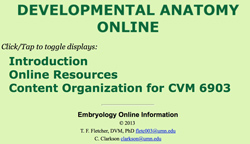
Embryology Courseware Online Summary (intended for CVM students)
This web page explains our organization of Embryology (Developmental Anatomy) courseware for online learning. It is a portal for our web resources and includes content organization.

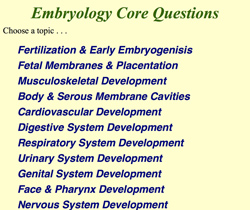
Embryology Core Questions
This computer web site (& mobile device web app) presents core questions related to eleven embryology (developmental anatomy) topics. The keyboard, buttons & a slider are available to navigate among questions per topic. Students are expected to think about how they would answer each question and then use the mouse or the spacebar to reveal answers/images provided by the instructor. Each question has a short answer followed by a detailed answer that delivers additional information.

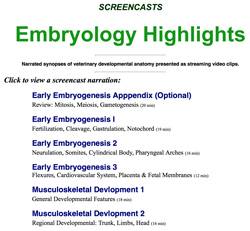
Embryology Highlights (Screencasts)
Veterinary Developmental Anatomy content is presented through a series of narrated video presentations (screencasts). Taken together, the series of screencasts constitutes an online Introductory Embryology course, subdivided into compact units. Initial units presenting fertilization, early embryogenesis, and placentation are followed by content units pertaining to body systems. (The screencasts were produced with Camtasia software. They are presented as 800 x 600px .mp4 streaming videoclips.)

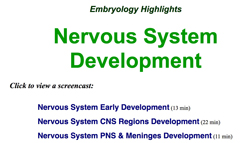
Embryology Highlights: Nervous System Development Screencasts
This web site presents links to narrated screencasts of nervous system embryonic development. Topics include: Early neural development, CNS development, and PNS & Meninges development. The screencasts (which are included in the Embryology Highlights listd above) were produced with Camtasia software; they are presented as streaming video clips (800 x 600px .mp4).

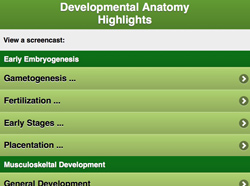
Embryology Highlights (Mobile Device Screencasts)
A version of Embryology Highlights for mobile devices (a web app designed for smart phones & tablets) is available. Taken together, the narrated video presentations (screencasts) constitute an online Introductory Embryology course, subdivided into compact units. Initial units presenting fertilization, early embryogenesis, and placentation are followed by content units pertaining to body systems

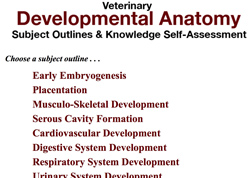
Developmental Anatomy: Subject Outlines & Knowledge Self-Assessment
This web site is intended to supplement class matrials that provide embryology images. It presents an Outline of Topics linked to True/False Questions with Explanations. The topical Outlines offer students another perspective of the subject matter. The Questions provide an opportunity to self-assess embryology knowledge prior to course examinations. The T/F Quizzes are geared for instruction, rather than grading. Embryology terms are shown in bold type.

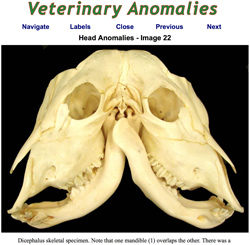
Veterinary Developmental Anomalies
This web site presents Dr. V. S. Cox's collection of veterinary developmental anomaly images. The images are organized by system and by region. Anomaly commentaries and links to PDF descriptions of normal developmental anatomy are included.

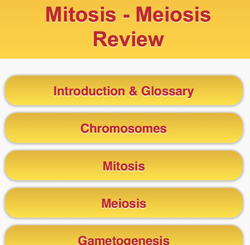
Mitosis-Meiosis Review (mobile web app)
This web app provides a review of mitosis and meiosis for veterinary students studying fertilization in Embryology. The Review illustrates how germ cells give rise to four haploid gametes with unique genotypes via meiosis, in contrast to mitosis which produces two identical daughter cells. Gametogenesis is also reviewed. The web app is designed for smart phones, but it may be viewed on tablet or computer browsers.

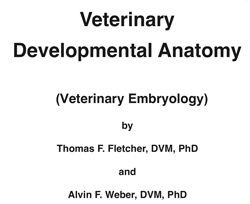
Developmental Anatomy Lecture Notes( PDF)
Developmental Anatomy class lecture notes (79 pages). The notes are in a PDF document (screen resolution).

External URL Links:
Link: Developmental Anatomy from University of Cordoba, Spain
Prof. J.G. Monterde of the Veterinary School, University of Cordoba, Spain, has developed an outstanding Developmental Anatomy web site. The free web site illustrates embryonic development via a comprehensive set of cartoon animations. Your browser must activate a Flash Player to view the animations.
Link: Comparative Placentation from University of California, San Diego.
Dr. Kurt Benirschke established a Comparative Placentation web site that describes placentas of numerous species, mostly collected from the San Diego Zoo.
- Embryology Courseware Online
- Embryology Core Questions
- Embryology Highlights (screencasts)
- Embryology Highlights: Nervous System (screencasts)
- Embryology Highlights (Mobile)
- Developmental Anatomy: Subject Outlines & Knowledge Self-Assessment
- Veterinary Developmental Anomalies
- Mitosis-Meiosis Review
- Developmental Anatomy Class Notes (PDF)

